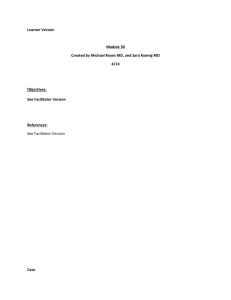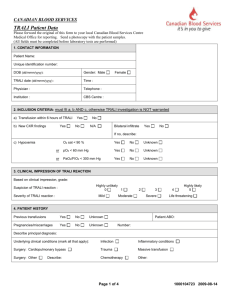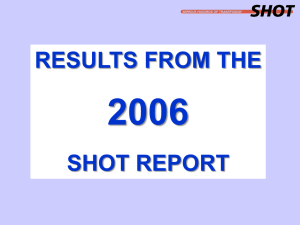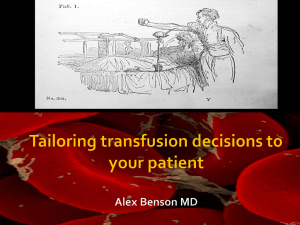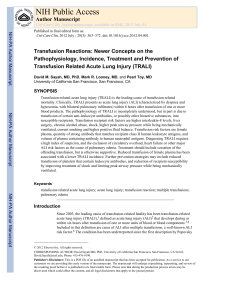Critical Care Medicine
advertisement
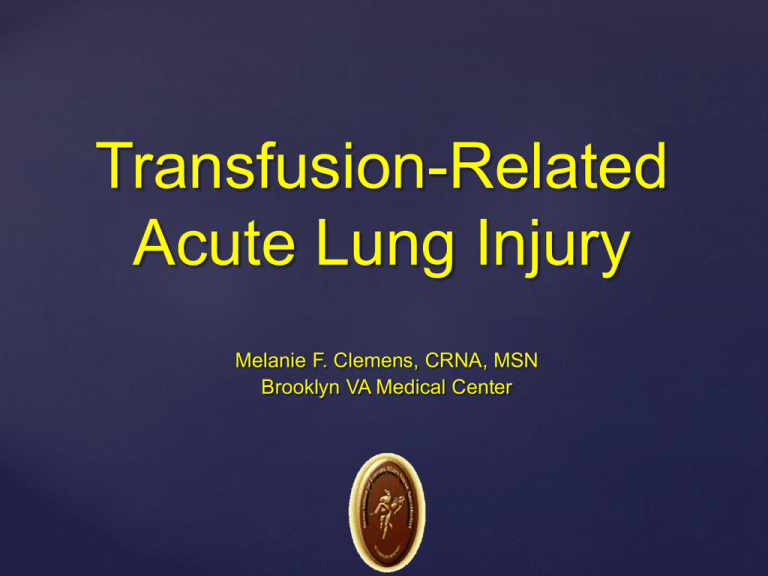
Transfusion-Related Acute Lung Injury Melanie F. Clemens, CRNA, MSN Brooklyn VA Medical Center Objectives Discuss the incidence of TRALI Review the proposed pathophysiology of TRALI Discuss the proposed risk factors associated with TRALI Review the clinical presentation & diagnosis of TRALI Review the treatment of TRALI Discuss the clinical impact of TRALI Disclosures Clinical Relevance TRALI 1 in 5,000 units* 1 in 625 patients* Bacterial Contamination Related Sepsis 1 in 25,000 platelets 1 in 250,000 PRBCs Hepatitis C Hepatitis B 1 in 1,935,000 transfusions 1 in 205,000 transfusions HIV 1 in 2,135,000 transfusions Clinical Relevance http://www.fda.gov/BiologicsBloodVaccines/SafetyAvailability/ReportaProblem/TransfusionDonationFatalities Presentation Within 6 hours of transfusion Symptoms Dyspnea Cyanosis Hypoxemia Pulmonary edema Hypotension Decreased lung compliance Fever Chills Cough Tachycardia Frothy sputum Absence of other clinical indicators of fluid overload Pathophysiology Antibody Hypothesis Human leukocyte antigen (HLA) Human neutrophil antigen (HNA) Biologic Response Modifiers Class I & class II Not antibody mediated Two-Hit Hypothesis 2 events Opportunistic Sachs 2011 Pathophysiology Antibody mediated lung injury 70% of TRALI cases HLA & HNA antibody formation 85%-90% component based 5%-10% recipient based Pregnancy Transplantation Transfusion Antibodies target WBCs Pulmonary microvascular infiltration & damage Dennison 2008 Pathophysiology Biologic Response Modifiers Accumulate in stored blood Activate & prime neutrophils Independent of antibodies Lower morbidity & mortality http://online.wsj.com/article/SB10001424052748703939404574567771148801570.html Pathophysiology Two-Hit Theory First event System activation Pulmonary endothelium Primed neutrophils Second event Transfusion Opportunistic Threshold Sachs 2011 Risk Factors Product related risk factors Triulzi 2009 Risk Factors Recipient related risk factors Sachs 2011 Diagnosis Unrecognized TRALI vs. TACO http://www.arabanesthesia.com/2011/03/association-between-intraoperative.html Diagnosis Transfusion-Related Cardiac Overload (TACO) Similar presentation to TRALI Jugular venous distension Hypertension Elevated pulmonary artery occlusion or central venous pressures* Prompt improvement of symptoms with diuresis Pulmonary edema/plasma protein concentration ratio <0.65 ≥50% increase in post transfusion BNP levels Presentation Within 6 hours of transfusion Symptoms Dyspnea Cyanosis Hypoxemia Pulmonary edema Hypotension Decreased lung compliance Fever Chills Cough Tachycardia Frothy sputum Absence of other clinical indicators of fluid overload Diagnosis Gilliss et al. 2011 http://jama.ama-assn.org/content/287/15/1968.full Diagnosis Gajic et al. 2006 Diagnosis Skeate et al. 2007 Treatment Differential diagnosis Stop the suspected product Supportive Intubation & mechanical ventilation Fluids Vasopressors 5%-20% mortality rate Retain the transfused products http://web.squ.edu.om Clinical Impact Prevention Limit unnecessary transfusions Donor limitations Leukocyte reduction Washing cellular components Pooled products Product testing Using freshest available products www.ag.ndsu.edu Clinical Impact Alternatives to transfusion Crystalloids Colloids Conservative transfusion thresholds Risk stratification Concentrated fibrinogen/Factor VII Vitamin K Questions References Curtis, Brian. McFarland, Janice. (2006). Mechanisms of Transfusion-Related Acute Lung Injury. Critical Care Medicine, 34, S118-S123. Dennison, Carol. (2008). Transfusion-Related Acute Lung Injury-A Clinical Challenge. Dimensions of Critical Care Nursing, 27, 1-7. Gajic, Ognjen. Gropper, Michael. Hubmayr, Rolf. (2006). Pulmonary Edema After Transfusion: How to Differential Transfusion-Associated Circulatory Overload from Transfusion-Related Acute Lung Injury. Critical Care Medicine, 34, S109-S113. References Gillis, Brian. Looney, Mark. Gropper, Michael. (2011). Reducing Noninfectious Risks of Blood Transfusion. Anesthesiology, 115, 635-649. Kopko, Patricia. (2010). Transfusion-Related Acute Lung Injury. Journal of Infusion Nursing, 33, 32-37. Looney, Mark. Gillis, Brian. Matthay, Michael. (2010). Pathophysiology of Transfusion-Related Acute Lung Injury. Current Opinion in Hematology, 17, 418-423. Mair, D. Hirschler, Nora. Eastlund, Ted. (2006). Blood Donor and Component Management Strategies to Prevent TransfusionRelated Acute Lung Injury. Critical Care Medicine, 34, S137S143. References Moore, S. (2006). Transfusion-Related Acute Lung Injury: Clinical Presentation, Treatment, and Prognosis. Critical Care Medicine, 34, S114-S117. Sachs, Ulrich. (2011). Recent Insights into the Mechanic of Transfusion-Related Acute Lung Injury. Current Opinion in Hematology, 18, 436-442. Skeate, Robert. Eastlund, Ted. (2007). Distinguishing Between Transfusion-Related Acute Lung Injury and TransfusionAssociated Circulatory Overload. Current Opinion in Hematology, 14, 682-687. References Triulzi, Darrell. (2009). Transfusion-Related Acute Lung Injury: Current Concepts for the Clinician. Anesthesia and Analgesia, 108, 770-776. Vlaar, Alexander. Binnekade, Jan. Prins, David. Van Stein, Danielle. Hofstra, Jorrit. Schultz, Marcus. Juffermans, Nicole. (2010). Risk Factors and Outcome of TransfusionRelated Acute Lung Injury in the Critically Ill: A Nested CaseControl Study. Critical Care Medicine, 38, 771-778. Federal Drug Administration (2010). Fatalities Reported to FDA Following Blood Collection and Transfusion. Annual Summary for Fiscal Year 2010. www.fda.org
